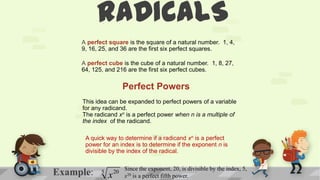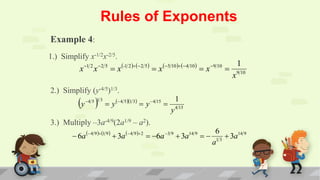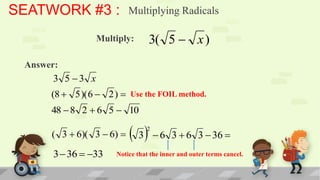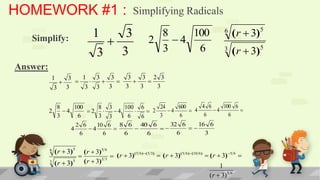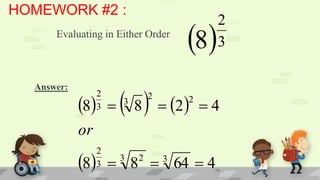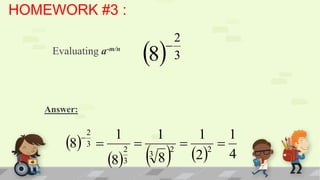Algebra
- 1. Radicals and Rational Exponents 19
- 2. RADICALS A perfect square is the square of a natural number. 1, 4, 9, 16, 25, and 36 are the first six perfect squares. A perfect cube is the cube of a natural number. 1, 8, 27, 64, 125, and 216 are the first six perfect cubes. Perfect Powers This idea can be expanded to perfect powers of a variable for any radicand. The radicand xn is a perfect power when n is a multiple of the index of the radicand. A quick way to determine if a radicand xn is a perfect power for an index is to determine if the exponent n is divisible by the index of the radical. Since the exponent, 20, is divisible by the index, 5, Example: 5 x 20 x20 is a perfect fifth power.
- 3. For all real numbers a and b and all rational numbers m For all real numbers a and b and all rational numbers m and n, and n, Product rule: am • an = am + n Zero exponent rule: a0 = 1, a 0 a m Raising a power to a power: a a m n m n a mn , a 0 an Quotient rule: Raising a product to a power : abm a m b m m m 1 a am a m, a0 m , b0 Negative exponent rule: a Raising a quotient to a power : b b Rational
- 4. Product Rule for Radicals For nonnegative real numbers a and b, n a n b n ab Example 1: 3 32 3 8 3 4 23 4 3 250 3 125 3 2 53 2 4 48 4 16 4 3 24 3
- 5. Quotient Rule for Radicals For nonnegative real numbers a and b, n a n a n , b0 b b Example 2: 81 81 9 100 100 10 75 25 Simplify radicand, if possible. 25 5 3 1
- 6. Quotient Rule for Radicals Example 3: 64 x 6 3 64 x 6 4x2 3 12 4 y 3 y12 y 64 x 5 64 x 5 32 x 2 16 x 2 2 3 4x 2 2x 3 2x 1 1 3a 6b5 3a 8 4 3a 8 4 a8 4 3 a2 4 3 4 2 13 4 8 16a b 16b 4 16b8 4 16b8 2b 2
- 7. Rules of Exponents Example 4: 1.) Simplify x-1/2x-2/5. 1 2 2 5 -1 2 2 5 5 10 4 10 9 10 1 x x x x x x 9 10 2.) Simplify (y-4/5)1/3. y 4 5 1 3 y 4 5 1 3 y 4 15 1 y 4 15 3.) Multiply –3a-4/9(2a1/9 – a2). 6 6a 4 9 1 9 3a 4 9 2 6a 3 9 3a14 9 3a14 9 a1 3
- 8. Factoring Expressions Example 5: 1.) Factor x1/4 – x5/4. The smallest of the two exponents is 1/4. x1/4 – x5/4 = x1/4 (1 – x5/4-(1/4)) = x1/4 (1 – x4/4) = x1/4 (1 – x) Original Exponent exponent factored out 2.) Factor x-1/2 + x1/2. The smallest of the two exponents is -1/2. -1/2 + x1/2 = x -1/2 (1– x1/2-(-1/2) ) = x -1/2 (1– x) = 1 x x x1 2 Original Exponent exponent factored out
- 9. SEATWORK HOMEWORK 1 1 2 2 3 3 4 4 5 5
- 10. SEATWORK #1 : Like radicals are radicals having the same radicands. They are added the same way like terms are added. 5 2 4 2 9 2 4 4 4 Answer: 54 2 44 2 94 2 3 xyz 10 xyz 5 xyz 8 xyz 2 2 2 2 65 7 75 6 Cannot be simplified further.
- 11. SEATWORK #2 : Adding & Subtracting To Add or Subtract Radicals 1. Simplify each radical expression. 2. Combine like radicals (if there are any). 3 250 5 160 3 y 4 48x5 x4 3x5 y 4 Answer: 3 250 5 160 3 25 10 5 16 10 3 5 10 5 4 10 15 10 20 10 35 10 3 y 4 48x5 x4 3x5 y 4 3 y 4 16x 4 4 3x x4 x 4 y 4 4 3x 3 y 2 x 4 3 x x xy 4 3 x 6 xy 4 3 x x 2 y 4 3x 4 3 x (6 xy x 2 y )
- 12. SEATWORK #3 : Multiplying Radicals Multiply: 3( 5 x ) Answer: 3 5 3 x (8 5 )( 6 2 ) Use the FOIL method. 48 8 2 6 5 10 ( 3 6)( 3 6) 3 6 2 3 6 3 36 3 36 33 Notice that the inner and outer terms cancel.
- 13. SEATWORK #4 : Rationalizing Denominators To Rationalize a Denominator Multiply both the numerator and the denominator of the fraction by a radical that will result in the radicand in the denominator becoming a perfect power. x2 5 pq 4 y3 2r Answer : x2 x2 y3 x 2 y 3 xy y x y 3 3 3 2 y y 3 y 3 y y y 5 pq 4 5 pq 4 2r 10 pq 4 r 10 pq 4 r q 2 10 pr 2r 2r 2r 2r 2r 2r
- 14. SEATWORK #5 : Simplifying Radicals Simplify by rationalizing the denominator: 5 c 2d 2 1 c d Answer : 5 5 2 1 5( 2 1) 2 1 2 1 2 1 2 1 c 2d c 2d c d c d c d c d ( c 2d )( c d ) c cd 2cd d 2 ( c d )( c d ) cd
- 15. HOMEWORK #1 : Simplifying Radicals 1 3 8 100 6 ( r 3) 5 Simplify: 2 4 3 3 3 6 3 ( r 3)5 Answer: 1 3 1 3 3 3 3 2 3 3 3 3 3 3 3 3 3 8 100 8 3 100 6 24 600 4 6 100 6 2 4 2 4 2 4 4 4 3 6 3 3 6 6 3 6 6 6 2 6 10 6 8 6 40 6 32 6 16 6 4 4 6 6 6 6 6 3 6 ( r 3)5 ( r 3)5 6 ( 5 6 ) ( 5 3 ) ( r 3) ( r 3)( 5 6 )(10 6 ) ( r 3) 5 6 ( r 3)5 ( r 3) 53 3 1 (r 3) 5 6
- 16. HOMEWORK #2 : 8 2 Evaluating in Either Order 3 8 Answer: 8 2 4 2 2 3 2 3 or 8 2 3 8 64 4 3 2 3 16
- 17. HOMEWORK #3 : 8 2 Evaluating a-m/n 3 Answer: 8 1 1 1 1 2 2 8 2 4 3 8 2 2 3 3
- 18. HOMEWORK #4 : y 1 1 1 Simplify: 6 6 a b ab2 3 Answer: y 1 6 6 6 y6 y 1 1 1 1 1 1 a 2b 3 ab a 2b 3 a b 1 1 1 1 a 2 b 3 3 2 a b 2 3 18
- 19. HOMEWORK #5 : Exponent 1/n When n Is Odd 1 1 1 27 1 5 27 3 3 32 Answer: 1 27 3 3 27 3 27 1 3 3 27 3 1 1 5 1 1 5 32 32 2 19
- 20. Submitted by: John Marion G. De Guzman 2nd year BTTE AUTOMOTIVE ALGEBRA 111


